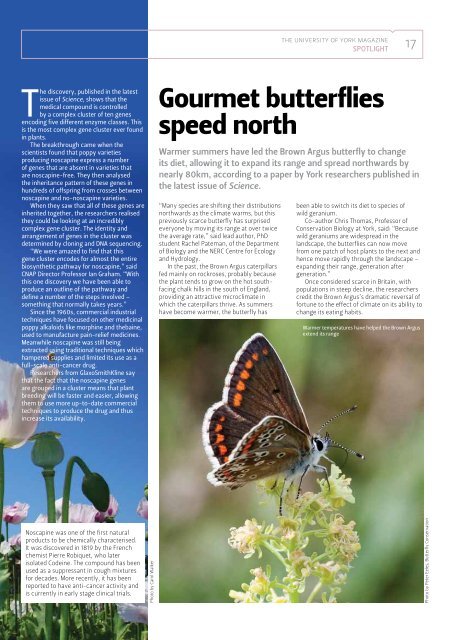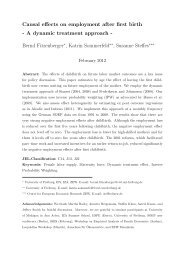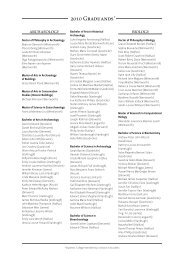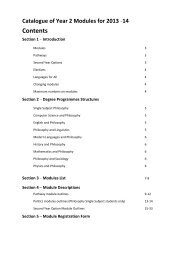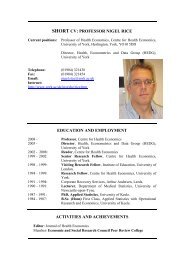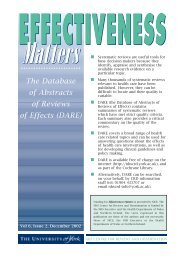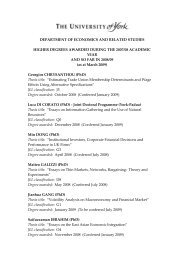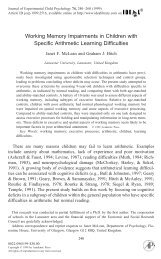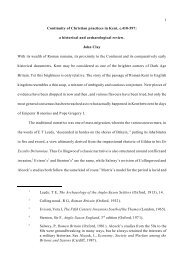Still life in British art: York's pivotal role in Tate ... - University of York
Still life in British art: York's pivotal role in Tate ... - University of York
Still life in British art: York's pivotal role in Tate ... - University of York
- No tags were found...
Create successful ePaper yourself
Turn your PDF publications into a flip-book with our unique Google optimized e-Paper software.
the university <strong>of</strong> york magaz<strong>in</strong>eSpotlight17The discovery, published <strong>in</strong> the latestissue <strong>of</strong> Science, shows that themedical compound is controlledby a complex cluster <strong>of</strong> ten genesencod<strong>in</strong>g five different enzyme classes. Thisis the most complex gene cluster ever found<strong>in</strong> plants.The breakthrough came when thescientists found that poppy varietiesproduc<strong>in</strong>g noscap<strong>in</strong>e express a number<strong>of</strong> genes that are absent <strong>in</strong> varieties thatare noscap<strong>in</strong>e-free. They then analysedthe <strong>in</strong>heritance pattern <strong>of</strong> these genes <strong>in</strong>hundreds <strong>of</strong> <strong>of</strong>fspr<strong>in</strong>g from crosses betweennoscap<strong>in</strong>e and no-noscap<strong>in</strong>e varieties.When they saw that all <strong>of</strong> these genes are<strong>in</strong>herited together, the researchers realisedthey could be look<strong>in</strong>g at an <strong>in</strong>crediblycomplex gene cluster. The identity andarrangement <strong>of</strong> genes <strong>in</strong> the cluster wasdeterm<strong>in</strong>ed by clon<strong>in</strong>g and DNA sequenc<strong>in</strong>g.“We were amazed to f<strong>in</strong>d that thisgene cluster encodes for almost the entirebiosynthetic pathway for noscap<strong>in</strong>e,” saidCNAP Director Pr<strong>of</strong>essor Ian Graham. “Withthis one discovery we have been able toproduce an outl<strong>in</strong>e <strong>of</strong> the pathway anddef<strong>in</strong>e a number <strong>of</strong> the steps <strong>in</strong>volved –someth<strong>in</strong>g that normally takes years.”S<strong>in</strong>ce the 1960s, commercial <strong>in</strong>dustrialtechniques have focused on other medic<strong>in</strong>alpoppy alkaloids like morph<strong>in</strong>e and theba<strong>in</strong>e,used to manufacture pa<strong>in</strong>-relief medic<strong>in</strong>es.Meanwhile noscap<strong>in</strong>e was still be<strong>in</strong>gextracted us<strong>in</strong>g traditional techniques whichhampered supplies and limited its use as afull-scale anti-cancer drug.Researchers from GlaxoSmithKl<strong>in</strong>e saythat the fact that the noscap<strong>in</strong>e genesare grouped <strong>in</strong> a cluster means that plantbreed<strong>in</strong>g will be faster and easier, allow<strong>in</strong>gthem to use more up-to-date commercialtechniques to produce the drug and thus<strong>in</strong>crease its availability.Gourmet butterfliesspeed northWarmer summers have led the Brown Argus butterfly to changeits diet, allow<strong>in</strong>g it to expand its range and spread northwards bynearly 80km, accord<strong>in</strong>g to a paper by <strong>York</strong> researchers published <strong>in</strong>the latest issue <strong>of</strong> Science.“Many species are shift<strong>in</strong>g their distributionsnorthwards as the climate warms, but thispreviously scarce butterfly has surprisedeveryone by mov<strong>in</strong>g its range at over twicethe average rate,” said lead author, PhDstudent Rachel Pateman, <strong>of</strong> the Dep<strong>art</strong>ment<strong>of</strong> Biology and the NERC Centre for Ecologyand Hydrology.In the past, the Brown Argus caterpillarsfed ma<strong>in</strong>ly on rockroses, probably becausethe plant tends to grow on the hot southfac<strong>in</strong>gchalk hills <strong>in</strong> the south <strong>of</strong> England,provid<strong>in</strong>g an attractive microclimate <strong>in</strong>which the caterpillars thrive. As summershave become warmer, the butterfly hasbeen able to switch its diet to species <strong>of</strong>wild geranium.Co-author Chris Thomas, Pr<strong>of</strong>essor <strong>of</strong>Conservation Biology at <strong>York</strong>, said: “Becausewild geraniums are widespread <strong>in</strong> thelandscape, the butterflies can now movefrom one patch <strong>of</strong> host plants to the next andhence move rapidly through the landscape –expand<strong>in</strong>g their range, generation aftergeneration.”Once considered scarce <strong>in</strong> Brita<strong>in</strong>, withpopulations <strong>in</strong> steep decl<strong>in</strong>e, the researcherscredit the Brown Argus’s dramatic reversal <strong>of</strong>fortune to the effect <strong>of</strong> climate on its ability tochange its eat<strong>in</strong>g habits.Warmer temperatures have helped the Brown Argusextend its rangeNoscap<strong>in</strong>e was one <strong>of</strong> the first naturalproducts to be chemically characterised.It was discovered <strong>in</strong> 1819 by the Frenchchemist Pierre Robiquet, who laterisolated Code<strong>in</strong>e. The compound has beenused as a suppressant <strong>in</strong> cough mixturesfor decades. More recently, it has beenreported to have anti-cancer activity andis currently <strong>in</strong> early stage cl<strong>in</strong>ical trials.Photo by Carol WalkerPhoto by Peter Eeles, Butterfly Conservation


